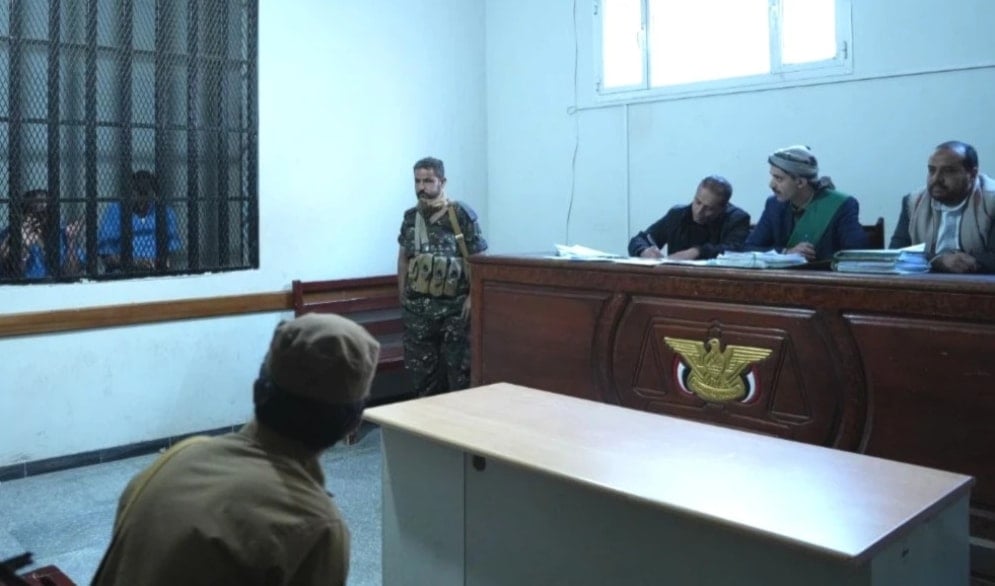Trial of network accused of foreign espionage in Yemen kicks off
Yemen begins trial of 21 suspects accused of aiding Saudi-US-Israeli intelligence as part of an espionage network targeting state security and leadership.
-

The Yemeni Specialized Criminal Court in the Capital begins the trial of defendants accused of operating in an espionage network linked to the joint enemy operations room (SABA)
The Specialized Criminal Court in the Capital Secretariat began its first session to try individuals accused of involvement in an espionage network, accused of links to a joint operations room shared by US intelligence, the Israeli Mossad, and Saudi intelligence, and reportedly based in Saudi territory.
The first session, presided over by the Chief Judge of the court, Yahya al-Mansour, and attended by the Chief Prosecutor, Judge Abdullah Zahra, along with the Deputy Prosecutor, Judge Sarim al-Din Mufaddal, was followed by a second session, which was presided over by Judge Rabee al-Zubair and included the attendance of prosecutor member Judge Nasr al-Qasimi.
During these sessions, the charges were formally read aloud, and the 21 defendants were subsequently confronted with the specific indictments and the evidence that had been gathered in the case.
Charges at hand
The charges involve collaborating with foreign states considered hostile to the Republic of Yemen: Saudi Arabia, the United Kingdom, and the United States, through communications with Saudi, British, American, and Israeli intelligence officers who directed the defendants' activities, supplied them with encrypted communication tools and geolocation applications, and trained them in the use of concealed cameras and live broadcasting systems.
The defendants are accused of supplying those entities with information on the locations and movements of state leaders, along with political, military, and security secrets. They are also charged with inciting and recruiting other citizens and installing multiple surveillance cameras, actions which resulted in the targeting of several military, security, and civilian sites.
The charges further included the destruction of devices and evidence necessary to prove crimes affecting state security and defense secrets, as well as assisting the aggressor state of Saudi Arabia and its allies in the war against Yemen.
This assistance was rendered through the recruitment of Yemeni individuals and the systematic collection of military and political information concerning Yemen, including details about first and second-tier leaders and media figures, their headquarters and affiliated institutions, the locations of their meetings and residences, and the sites of weapons manufacturing and storage.
Other charges entail providing Saudi intelligence with information regarding missiles, including their sources and launching and storage locations, along with assessments of internal front cohesion and reports concerning military leaders and their meeting places, all in return for financial compensation.
Yemen announces capture of joint CIA-Mossad-Saudi intelligence network
The Yemeni Ministry of Interior announced on November 8, 2025, that security forces had successfully dismantled an espionage network linked to a joint operations room involving the CIA, Mossad, and Saudi intelligence services.
The statement described the operation as part of "Operation And Their Plot Will Perish" and noted that the spy cells were directed from Saudi territory and supplied with advanced surveillance equipment.
According to the Ministry’s release, the cells had been under close observation and intelligence monitoring, enabling the security forces to trace the network’s communication links, encrypted devices, and geolocation applications before moving to arrests.
The announcement emphasized that the training of these operatives had taken place inside Saudi Arabia under the supervision of foreign officers and that the network’s structure involved multiple independent cells connected to a central command.
Officials in Sanaa described the development as a “major security breakthrough” and portrayed the timing as linked to broader regional conflict dynamics, including the war on Yemen and the network’s role in facilitating attacks against civilian and military infrastructure.

 4 Min Read
4 Min Read










